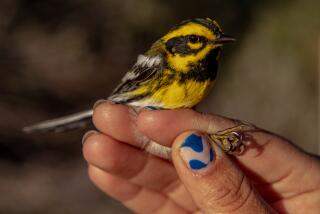Pecking Orders Birders and Twitchers: Equally Avid Avian Watchers--but With Different Techniques
- Share via
AMERICANS AND the British are not only separated by a common language but they also seem not to understand one another’s sports. Though Americans are beginning to watch soccer, it is not the sport of enormous popularity in America that it is in Britain, and cricket is quite incomprehensible to Americans.
It seems to me that the one sport that might bring us together is birding. I am awed by the dedication and vigor our British cousins bring to that gentle sport. Recently, thanks to a clipping from the Guardian sent to me by Jim and Suzan Moore, now residents of Cambridge, I told how a mob of 2,000 twitchers tramped through a Norfolk woods for a glimpse of a rare red-breasted nuthatch reported in that neighborhood.
A twitcher is a birder who is interested only in adding another bird to his life list and will go to any lengths, using any kind of conveyance, to accomplish those ends. Ordinary birders--who seek mainly the fresh air, exercise and communion with nature that their sport affords--do not especially like twitchers.
More recently, however, Alice Everett McCloskey sent me a clipping from the Dickinson (N. D.) Press that reported on the National Audubon Society’s Christmas bird count in and around Medora. Although the windchill factor was 30 degrees below zero, 15 hardy Dakotans showed up for the count. The sky was overcast, and the sun did not shine as they fanned out from Theodore Roosevelt National Park Visitor’s Center at 7:30 a.m.
One group consisted of two men and their sons, ages 10 and 6. As the Press put it, “the four-man crew was armed with binoculars, bird books and had their eyes peeled for fluttering wings.” They soon sighted a rooster ringneck pheasant and heard a chickadee.
Altogether, that group sighted 10 species, including a golden eagle, sharp-tailed grouse, black-tailed magpies and robins. Evidently, though, the cold kept many birds in their hiding places, but the birders also saw species of wildlife other than birds, including deer, a herd of antelope, a porcupine, a coyote and many cottontails. Meanwhile, the sun remained hidden, and the birders were assaulted by continuous snow flurries.
Surely, birders as hardy as those Dakotans could identify with British birders and twitchers. The weather in the British Isles is not that much better than it is in North Dakota.
Recently, the Moores sent me another clipping from the Guardian, updating the birding scene in England. It notes that twitchers, the more aggressive of the two kinds of birders, spend much time telephoning Birdline, a British service that reports on rare sightings. No matter how distant the sighting may be, the true twitcher makes a beeline for the location by whatever transportation is at hand. Some twitchers have gone to extraordinary lengths to add one bird to their list.
One birder who owns a private jet keeps it fueled up so he can speed on an instant’s notice to a distant sighting. In 1988, four Cambrian lads drove 500 miles in 14 hours, sighting 138 birds along the way.
Inevitably, such exertions sometimes come a cropper. Last year, a group of twitchers were hiding in a reed bed near Portsmouth, hoping to sight a rare red-breasted pochard. Alas, it took off and flew into a passing car, “reducing itself to a pathetic bunch of feathers.”
Twitchers sometimes get out of hand. Recently one was jailed for throwing rocks into a bush to disturb his quarry. But twitchers are said to be trying to discourage this kind of misconduct among their own.
Twitchers are often frustrated. Those 2,000 who tramped through the Norfolk woods in search of the red-breasted nuthatch heard later that the bird had been seen miles away by a woman walking her dog.
A boat full of twitchers was heading toward the Isles of Scilly when a storm blew up. The boat heaved about for 15 hours, unable to make harbor, and the seasick twitchers returned empty-handed to Penzance.
The Guardian repeats the well-known story of an American bird that accidentally landed in the Scillies some years ago. As hundreds of twitchers trained their ‘scopes, snapped pictures and scribbled notes, a cat crept up and carried off their quarry.
Richard Millington, a founder of Birdline, acknowledges his addiction to twitching. “I admit it’s an obsession. I suppose I have missed out on many other things, but I can’t imagine what life would be like without twitching.”
It seems to me that Anglo-American relations would be improved if a number of British birders and twitchers were to come to North Dakota for the annual Christmas count. They could probably add some unusual birds to their lists, and at least they might see a porcupine.
They’d best wear their ear muffs, though.
More to Read
Sign up for Essential California
The most important California stories and recommendations in your inbox every morning.
You may occasionally receive promotional content from the Los Angeles Times.










